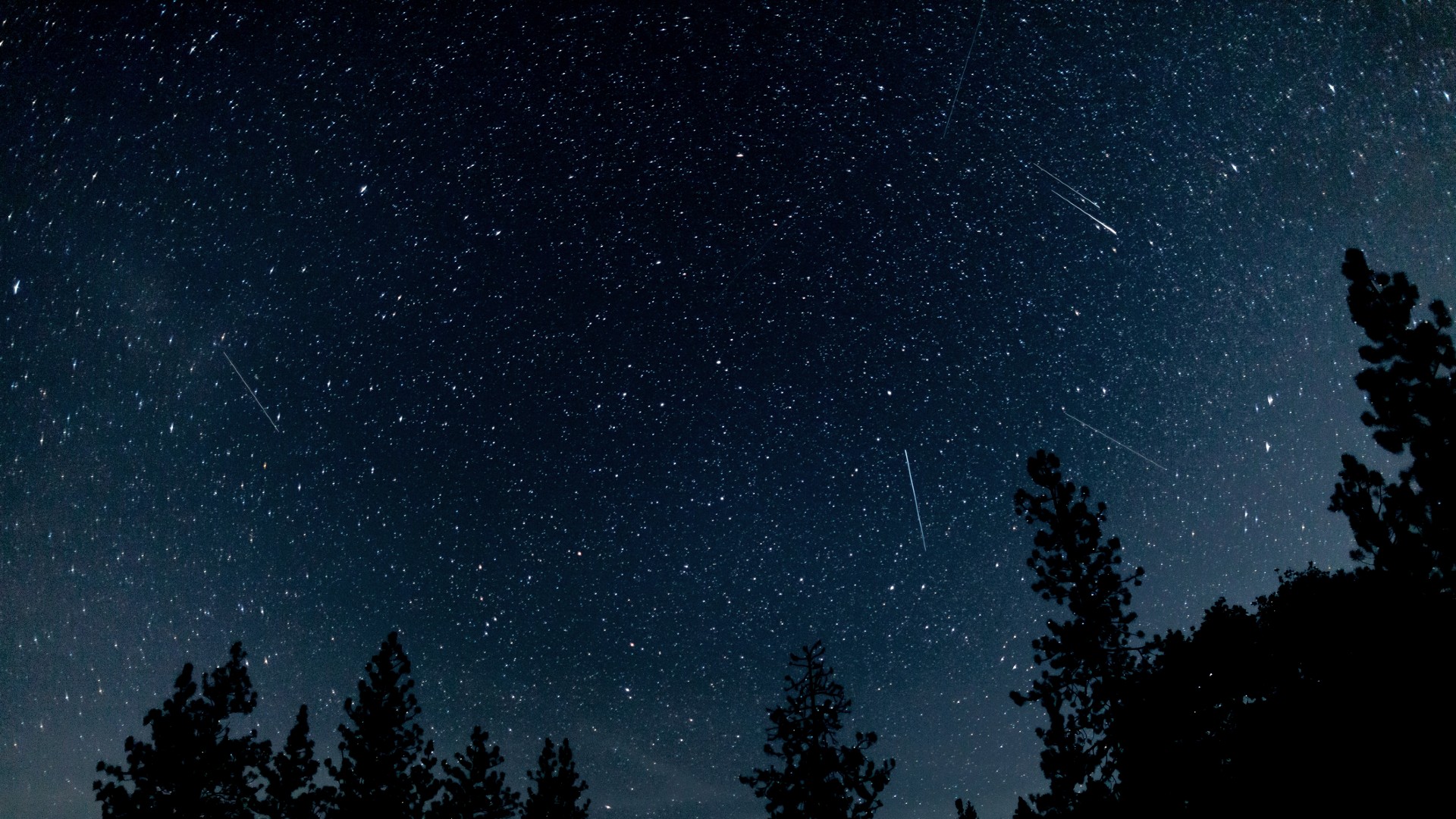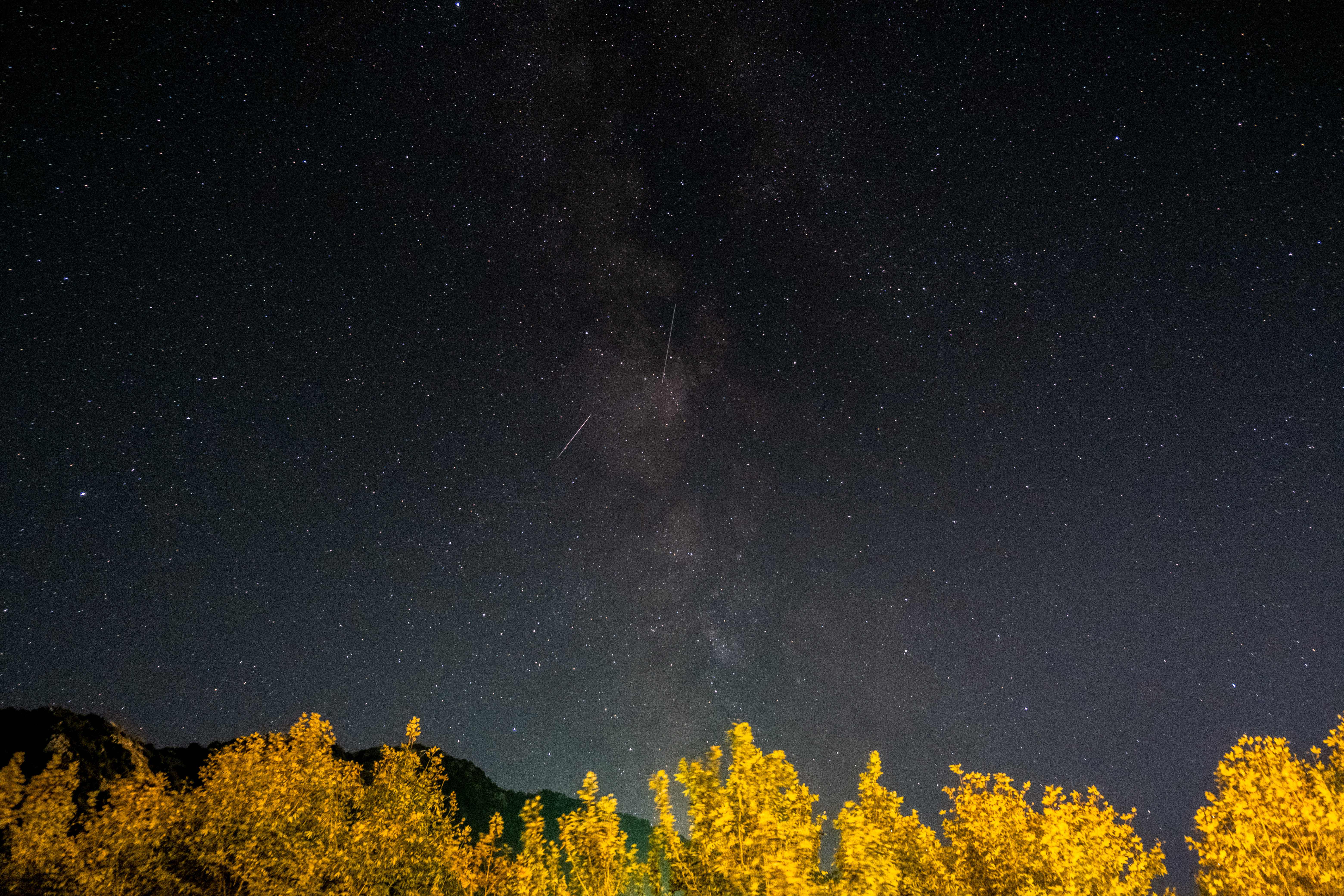The Orionid meteor shower peaks Oct. 21. Here's what to expect

For a few days centered on Oct. 21 each year, the Earth sweeps through a swarm of meteoroids known as the Orionids; widely scattered bits and pieces shed by the most famous of all comets, Halley's Comet.
Actually, this is the second time this year that we will cross this very same stream. We also pass through it at a different part of our orbit for several days during the early part of May, at which time they're darting out of a different part of the sky and are called the Eta Aquarids. In May, Earth encounters the debris left behind by Halley's Comet as it moves outbound from the sun, while in October we cross Halley's inbound path. The comet itself comes no closer than several million miles to the Earth's orbit, but the dust spreading out from it over time is what causes both the Eta Aquarid meteors of May and the Orionid meteors of October.
But before we get into the specifics about when, where and how you might enjoy this month's Orionid shower, let's talk about the specifics of what meteors are.
Related: Orionid meteor shower 2022: When, where & how to see it
Tiny particles heat the air
Meteors appear as streaks of light that are popularly referred to as "shooting stars" or "falling stars," though they are not really stars at all. In reality they are grains of dust, which have been gliding for countless thousands of years in the spaces between the planets. When one of them happens to impact the Earth's atmosphere, the flaming flash that is ultimately created is not what you might think, for the meteoroid itself is not what lights up at all; it is the incandescence of the air ahead of it that could not get out of the way fast enough!
Entering the atmosphere at speeds as high as 45 miles (72 km) per second, atmospheric friction releases the kinetic energy of the object in a short-lived streak of light that we momentarily see about 60 miles (100 km) above the ground. The energy released per gram of the meteoroid's weight far exceeds the energy efficiency of the most powerful man-made explosives. Thus, a pea-sized object can blaze across the sky with a brilliance rivaling Jupiter or Venus.
Some meteors leave bright trails that remain in the sky for a few seconds or more, but most appear as just faint streaks. So, if your sky is somewhat hazy, or there are bright lights in your vicinity, or if you're not alert, you won't see many. A few have noticeable colors, in part caused by the chemicals in them, but chiefly due to their speed as they move through the upper atmosphere. Slow meteors usually appear orange or red, while fast meteors appear white, occasionally tinged with hues of blue or green.
Breaking space news, the latest updates on rocket launches, skywatching events and more!
Read more: Meteor showers and shooting stars: Formation and history
Moving from the back of the train to the front
The best time to look for meteors is during the second half of the night, that is between midnight and the first light of dawn. Not only are you more likely to catch sight of meteors during this time frame, but the meteors that you do see tend to be brighter than ones you might see earlier in the evening.
The reason is that meteoroids are moving in all directions in space, but the Earth is moving around the sun in one direction, in essence like a very fast train, speeding at 18.5 miles (29.8 km) per second. In the evening we're on the caboose of the train — looking backward. Unless a meteoroid was going at least as fast as the train, it would never catch up. Even fast meteoroids would seem to slow down, since you are moving away from them. So, in the evening all meteors seem slower as the Earth recedes at 18.5 miles (29.8 km) a second.
In the early hours of the morning, however, the situation is reversed. You're no longer in the caboose, but have now moved up front with the engineer — on the forward side of Earth. Now, even a slow meteor seems to be moving rapidly, because Earth is whizzing toward it at the rate of 18.5 miles (29.8 km) per second. The only meteoroids escaping collision are those ahead of the Earth moving in the same direction with velocities exceeding 18.5 miles (29.8 km) per second. All others we will either overtake or meet head-on. Therefore, on average, morning meteors appear faster, hotter and brighter than those we see in the evening.
Read more: Halley's Comet: Facts about history's most famous comet
Random streaks
All these meteors which keep coming steadily, from any direction, at any time are called "sporadic" meteors, meaning there's no pattern to them. Typically, if you gaze skyward for an hour under a dark, clear sky, you should see at least a few meteors. The average is about 3 to 6. In other words, you may make a meteor sighting about once every 10 to 20 minutes.
This year's Orionids
This year, according to the 2022 edition of the Observer's Handbook of the Royal Astronomical Society of Canada, the best time to watch for Orionid meteors will come during the predawn hours of Friday morning (Oct. 21). The shower's radiant — that spot on the sky where the meteors appear to emanate from — is next to Orion's club, so the Orionids only become active in the hours after midnight and become most numerous before dawn when Orion the hunter wields his club high. The later before the first light of dawn (around 5:40 a.m. local daylight time), the higher it is. The Orionids are generally considered to be the third most reliable meteor display after the December Geminids and the August Perseids. Ancient Chinese chronicles suggest that the Orionids may have been first recorded in 288 AD, according to Sky and Telescope.
As for the moon, this year it will be a slender crescent in the constellation of Leo, just 17 percent illuminated and not due to rise until just before 3 a.m. local daylight time. Even just before the start of morning twilight, it will about one-third of the way up in the east-southeast sky and is not likely to prove to be much of a hindrance in observing this year's Orionid shower.
Actually, thanks to the numerous times that Halley's Comet has swept around the sun, the Orionids appear to be a multiple stream, consisting of at least two separate radiants, and meteors from these are sometimes seen to cross each other's paths.
Our best cameras for astrophotography and best lenses for astrophotography can help you take the best meteor shower images you can, no matter your skill level.
Orionids are ultra-swift meteors, moving on the order of 42 miles (67 km) per second, because they smack into Earth almost head-on. About 30 to 40 percent are quite bright and leave trains which persist for about a second or two and a small fraction of these might even be classified as fireballs — rivaling the brightest stars. But the majority of these colorful meteors are generally faint.
The first forerunners of this stream have been sighted as early as Oct. 2, while the last stragglers have been recorded as late as Nov. 7.
Read more: Orion Constellation: Facts, location and stars of the hunter
Under an excellent dark sky, you might count as many as 10 to 20 swift Orionids early Friday (Oct. 21) morning and about one-half to one-quarter of these numbers both on Thursday morning (Oct. 20) and Saturday morning (Oct. 22). You'll need patience, a comfortable reclining lawn chair, a wide-open sky view with no bright lights intruding and plenty of bundling against the chill of a late October morning.
Concentrate on that part of the sky overhead and toward the south and southeast. Keep your eyes moving around and don't stare at any one place; keep looking all over.
Halley's Comet — the mother of all Orionids — is currently near the far end of its elongated orbit, about 3.3 billion miles (5.3 billion km) away, and won't be back until the summer of 2061.
Sadly, some of us will not be around to greet it. But on one of these chilly October mornings, perhaps you can greet a few of its children.
Editor's note: If you snap a great photo of an Orionid meteor you'd like to share with Space.com and our news partners for a story or image gallery, send images and comments in to: spacephotos@space.com.
Joe Rao serves as an instructor and guest lecturer at New York's Hayden Planetarium. He writes about astronomy for Natural History magazine, the Farmers' Almanac and other publications. Follow us on Twitter @Spacedotcom and on Facebook.

Joe Rao is Space.com's skywatching columnist, as well as a veteran meteorologist and eclipse chaser who also serves as an instructor and guest lecturer at New York's Hayden Planetarium. He writes about astronomy for Natural History magazine, Sky & Telescope and other publications. Joe is an 8-time Emmy-nominated meteorologist who served the Putnam Valley region of New York for over 21 years. You can find him on Twitter and YouTube tracking lunar and solar eclipses, meteor showers and more. To find out Joe's latest project, visit him on Twitter.



